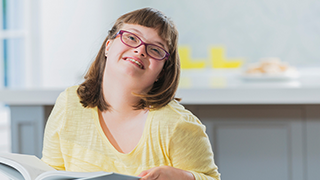HOW CAN WE HELP YOU? Call 1-800-TRY-CHOP
In This Section
New Study Explores In-Home Sleep Apnea Evaluation for Children With Down Syndrome
Obstructive sleep apnea affects a disproportionate number of children with Down syndrome – 40 to 50 percent – compared to the 3 to 5 percent of their typically developing peers who are affected. Obstructive sleep apnea occurs more frequently during REM sleep, a sleep stage during which the body is completely relaxed, allowing the upper airways to become partially or completely blocked. Children with Down syndrome have midfacial hypoplasia, enlarged tongues, and baseline low muscle tone, all of which make them more prone to obstructive sleep apnea. These repeated obstructions in breathing can cause oxygen deprivation, carbon dioxide retention, and repeated awakenings that prevent children from getting a good night’s sleep.
“Some of the potential outcomes of obstructive sleep apnea in the otherwise healthy population as well as in children with Down syndrome are behavioral and neurocognitive issues,” said Andrea Kelly, MD, MSCE, attending physician in the Division of Endocrinology and Diabetes. “Obstructive sleep apnea, independently of obesity, is also associated with cardio-metabolic outcomes including hypertension, higher blood sugar, and inflammation, none of which has been adequately researched in the Down syndrome population.”
 On the left, Andrea Kelly, MD, MSCE and on the right is Ignacio Tapia, MD.
On the left, Andrea Kelly, MD, MSCE and on the right is Ignacio Tapia, MD.
Supported by a grant from the Eunice Kennedy Shriver National Institute of Child Health and Human Development as part of the INCLUDE (Investigation of Co-occurring conditions across the Lifespan to Understand Down syndrome) project, co-principal investigators Dr. Kelly and Ignacio Tapia, MD, attending pulmonologist in the Division of Pulmonary Medicine, will explore options for home-based evaluation for obstructive sleep apnea. While the American Academy of Sleep Medicine does not currently support in-home sleep apnea testing for children, Dr. Tapia and Dr. Kelly, who are both associate professors of Pediatrics at the Perelman School of Medicine of the University of Pennsylvania, hope their research will provide a foundation of scientific proof to shift that thinking and provide a novel diagnostic tool and quicker path to treatment for obstructive sleep apnea in children and youth with Down syndrome.
Easing Diagnosis
The gold diagnostic standard for obstructive sleep apnea is the in-lab sleep study that involves an overnight stay in the Sleep Center and application of dozens of sensors, leads, and straps to measure movement, in addition to a nasal probe and pulse oximeter.
“It's a lot, especially for a child with sensory issues that may be complicated when sleeping away from their usual environment,” Dr. Tapia said.
Families can be understandably reluctant for their child participate in an onsite sleep study, so Dr. Tapia and Dr. Kelly will investigate whether or not it is possible to accurately complete these studies in the home. The investigators have been working alongside Melissa Xanthopoulos, PhD, MS, a behavioral psychologist at CHOP who specializes in intervention adherence and has a particular interest in individuals with developmental disabilities.
They plan to recruit 35 individuals with Down syndrome between 10 and 20 years of age to have in-lab sleep studies and also to complete in-home studies to find out if the in-home sleep study is acceptable to and feasible for families, and also how well the output from the in-home sleep study aligns with the data obtained in the lab, Dr. Kelly explained.
Potential Neurocognitive Benefits
A common treatment for obstructive sleep apnea in typically developing children is adenotonsillectomy; however, since children with Down syndrome have additional contributing factors, the procedure may not have the desired curative effect.
“This is why we have a significant population of children with Down syndrome who require treatment with positive airway pressure, whether continuous positive airway pressure or bilevel positive airway pressure,” Dr. Tapia said.
Drs. Tapia and Xanthopoulos will gather information by interviewing families of children with Down syndrome and obstructive sleep apnea who are currently being treated with continuous or bilevel positive airway pressure as part of a second INCLUDE-funded project that will be conducted both at CHOP and Cincinnati Children’s Hospital Medical Center.
Through these interviews, they hope to learn what worked and what didn’t work for children and families during the therapy desensitization process; what support they had and/or wish they had; and, most importantly, what outcomes they think are important to include in future randomized controlled trials.
“As healthcare providers, we have a clear idea of what we need to know,” Dr. Tapia said. “But a family may have a different idea. So we're trying to marry both and incorporate the feedback of the parents.”
The interviews will be followed by a randomized clinical trial that will evaluate if children with Down syndrome experience improved behavioral and cognitive function following treatment of obstructive sleep apnea, as well as effects of treatment upon quality of life and cardiac health. While children with Down syndrome have developmental disabilities, typically developing children with untreated obstructive sleep apnea demonstrate neurobehavioral deficits that can reverse with treatment. This effect has been observed clinically in children with Down syndrome but has not yet been rigorously tested.
INCLUDE: Advancing Research on Down Syndrome
These studies to explore options for home-based evaluation for obstructive sleep apnea and conduct clinical trials to address sleep apnea outcomes in children with Down syndrome are among several projects at CHOP supported by INCLUDE, which increased funding for new grants to $35 million for fiscal year 2019.
In response to advocacy by individuals with Down syndrome, their families, and healthcare providers to address the dearth of available data concerning the Down syndrome population and the comorbidities that affect them, the NIH began the INCLUDE project in 2018. INCLUDE investigators focus on critical health and quality-of-life needs for individuals with Down syndrome and conditions such as Alzheimer’s disease, dementia, autism, cataracts, celiac disease, congenital heart disease, and diabetes. Aims of the project are to conduct targeted, high-risk, high-reward basic science studies on chromosome 21; assemble a large study cohort of individuals with Down syndrome; and include individuals with Down syndrome in existing clinical trials.
Other CHOP projects receiving INCLUDE funding are the Gabriella Miller Kids First Data Resource Center, which will incorporate DNA samples from individuals with Down syndrome into its existing repository of whole-genome sequence and clinical data; and a research study within the Stella Chou Laboratory that strives to understand the complexity of gene dosage imbalance in Down syndrome. In addition, as part of the NIH Autism Center of Excellence Infant Brain Imaging Study Network, CHOP’s Center for Autism Research joins a longitudinal multisite MRI study that will create a cohort of infants with Down syndrome, data from which can help address recommendations for investigation of comorbid autism, characterize cardiovascular and other potential physical health characteristics, and conduct future biospecimen analyses.
 By
By